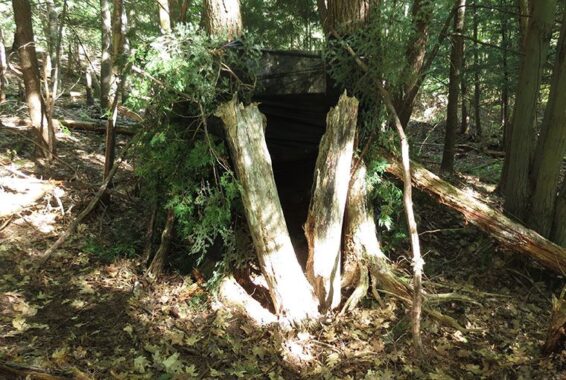Want the thrill of hunting from the ground? I know that there’s nothing quite like the excitement of hunting a deer that is only a few yards away from you. One way to help you get that experience is to build a ground blind for deer hunting.
The thrill that you will get when you are eye-level with your prey is indescribable. But it is also more difficult. This article will help teach you:
- The advantages of hunting from the ground.
- Where to put your ground blind.
- How to build a ground blind for deer hunting.
Why Should You Hunt from the Ground?
It isn’t just more enjoyable to hunt from the ground. It’s also practical. Think of our ancestors—they didn’t have a tree stand that they could pick up from the store. Instead, they had to find creative ways to hide.
You’ll find that it’s easier to be quiet from the ground. There’s no metallic squeaking like you get when up in a tree stand or a box stand.
Hunting from the ground will also help you feel more connected to nature. If you have young hunters along with you, they’ll learn how to stay still and be quiet.
Being so close to your quarry, you’ll really gain an appreciation for their senses.

Why Build a Ground Blind?
You could just dig a hole to sit in and successfully hunt from the ground. And maybe if you solo hunt a lot, that could be a good option for you. But if you like to hunt with another person or your kids, you might want to have some more room.
You could head to the local hunting store and buy a pop-up ground blind. However, the advantages of building one yourself can give you a leg up to help you snag the best deer possible. And you’ll save some of your hard-earned money.
Safety from the Elements
There’s weather to consider. It’s no fun getting rained or snowed on. Even the wind can be a factor during the hunting season. A ground blind can give you a little cover from those elements while keeping you hidden.
Cover Your Scent
A ground blind also allows for some amount of scent containment. Being in a small enclosure can trap your scent more than just being out in the open. Some people like to add scent elimination products to their ground blind to reduce the scent, making it easier to hunt.
Pro Tip: Using fragrant elements, like pine needles, can help ‘mix’ your scent instead of hiding it. Some hunters find this more effective. Rub them over your hands and clothing, then stuff them into your pockets. Replenish them throughout the hunting day to keep the scent fresh.
Camouflage
Building your own ground blind gives you better control of camouflage. You’ll be able to make sure it really blends into the area around it, making it even more effective. By using materials from the hunting location, it will be much more effective.
Finding Your Ground Blind Spot
Location
The key to a successful ground blind is a great location. Look for bedding areas and food sources. Deer will leave the bedding area and head to the food source. This way, you will know the path they will take.
You should be able to see the feeding area, but not let the deer easily see you. You can use a wireless or wifi trail camera to see the area on your phone without worrying about deer detecting your presence.
Pro Tip: Areas near large food sources, like a soybean field, can be great locations.
Here is a video on ground blind placement:
Blending In
Once you have your location picked out, you need to look for some natural cover. You want the ground blind to blend in. If you can build it in advance, that will be even better. That way the deer will get used to it.
You should be able to hear the deer approach before you see them. It may also help to keep the sun at your back. That way your vision will be clear. If the deer look toward the blind, they may be blinded by the sun.
Building the Ground Blind
Now that you have your spot, it’s time to build a ground blind.
Like I mentioned before, you will want to have the ground blind blend in. The more natural elements that you can use, the better. Here is a good example:

Setting Up
If you can set up the blind weeks ahead of time, you should take advantage and do that. This isn’t always possible, but it will allow the deer to become used to the blind.
You’ll need some materials to build your blind. These can be very inexpensive. One option, like the image above, uses weed barrier cloth, a ground tarp, and paracord. You can also use chicken wire.
Another good option is to use baling wire, jute twine or cotton cord to build walls for your blind. Your imagination is the limit.
Regardless of what you build your ground blind out of, you’ll want to assemble walls that help to conceal you from the deer. You should be able to enter and exit the ground blind without deer being able to see you.
Make sure the ground is bare to eliminate noise that will scare your quarry. A roof may be a good option in some cases, or not in others. It depends on the weather as well as how long you are planning on leaving the blind up.
Concealing Your Blind
You’ll want to bring your materials to the location and look for ways to incorporate the brush and natural cover that there already is. Look for large items to incorporate. Tree limbs with dense leaves and hay will provide additional camouflage.

Pro Tip: Always clear a ‘lane’ leading to where you want to intercept the deer. Make sure that high grass, branches, and other obstacles are cleared to give you the best possible opportunity to take down your quarry.
Hopefully, you have found the information and inspiration that you need to build your own ground blind. Hunting from the ground can be more difficult than from an elevated position. But it can be more exciting and leave you feeling more connected to nature.
Last Updated on January 4, 2024 by Marty Prokop





